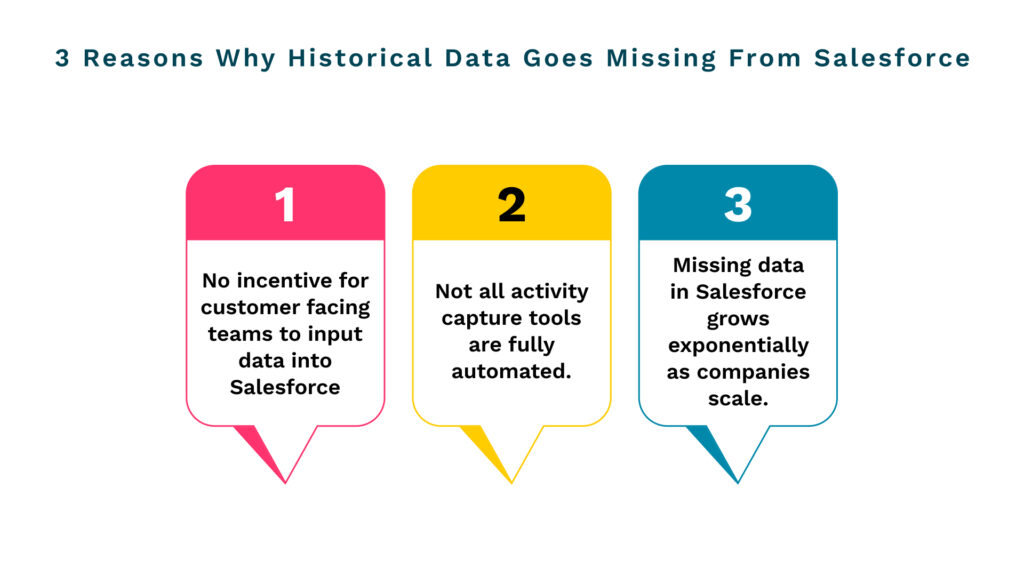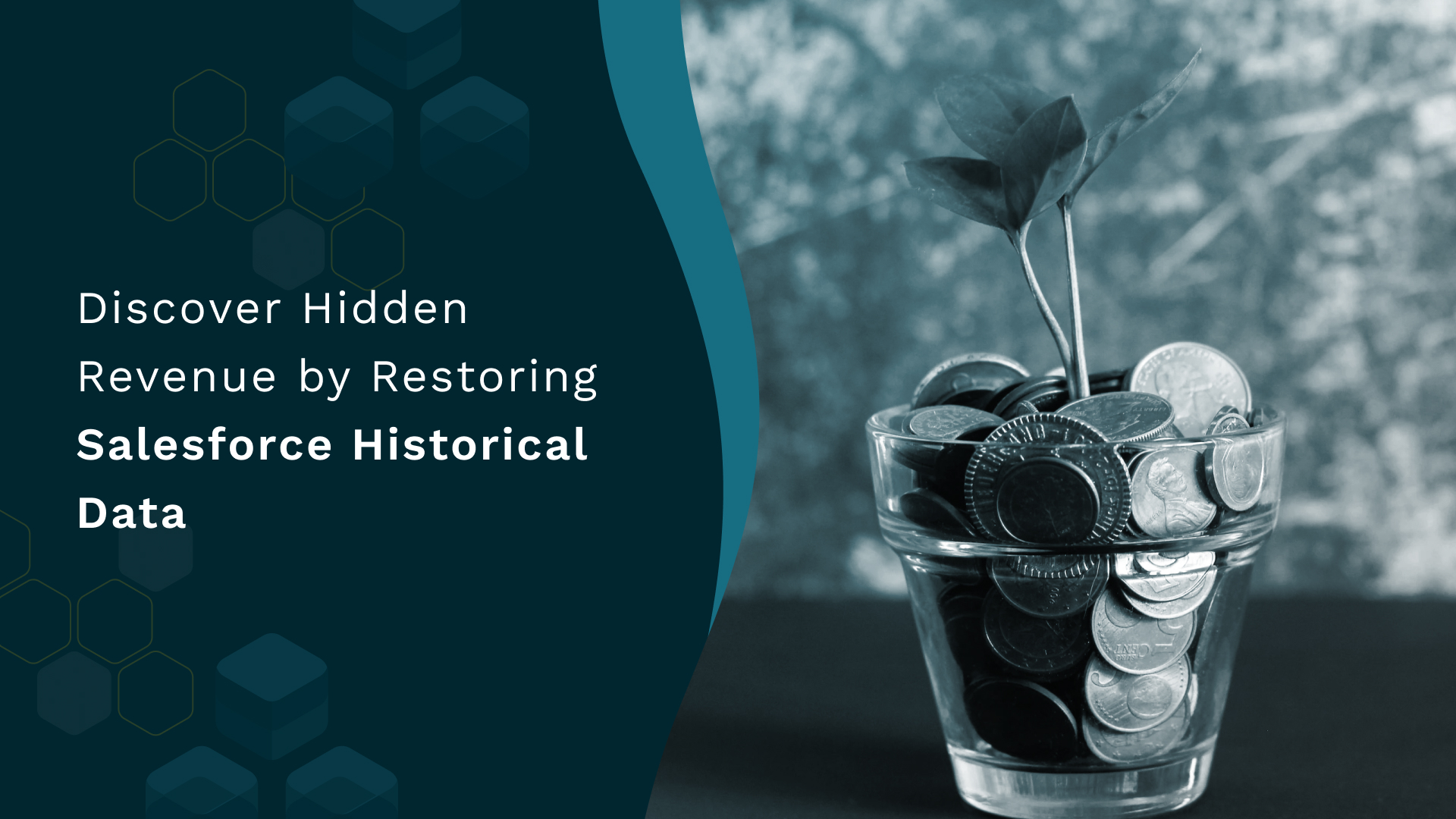2023 is transforming how businesses approach ‘growth’. For the last 10-15 years, capital flowed freely. Businesses received funding effortlessly. The only focus was ‘growth at all costs’. Profitability was only considered during the very late stages or when preparing to go public.
But today, with capital becoming expensive, there’s a shift in mindset when it comes to ‘growth’. Businesses, big and small, new and old, are being measured on capital efficiency. There’s a tremendous focus on ‘efficient growth’.
And how does efficiency work? Efficiency works on the concept of doing more with less.
This is exactly why companies are focusing more on customer success-led growth and account expansions to achieve efficient growth instead of traditional sales and marketing channels.
However, there’s yet another channel that is being overlooked – a company’s Salesforce historical data.
Unfortunately, most of this data is either missing, incomplete, or outdated.
The Problem of Missing Salesforce Historical Data
GTM data should be available in your Salesforce CRM. However, a major pain point that businesses often encounter is the incomplete availability of data in Salesforce.
While it is crucial for all essential information such as contacts, emails, and meetings to reside in Salesforce CRM, 50-70% of this data is frequently missing.

There are several reasons contributing to this issue.
Firstly, customer-facing teams are typically not incentivized to update the CRM beyond their primary goal of generating leads. Consequently, they may neglect to input crucial details and updates into the system, leading to gaps in the data.
Secondly, although there are existing tools designed to assist businesses and customer-facing teams in capturing activity, they vary in their level of automation. Some tools are fully automated, while others are only semi-automated.
However, since activity capture is not the primary focus or “hero product” of these companies, the functionality of these tools may be limited. As a result, not all data is captured, leading to incomplete information and missing data.
Lastly, as businesses grow and teams expand, the amount of missing data becomes even more significant. For instance, if one person in the team fails to add data to Salesforce, there will be a certain amount of missing data, let’s call it “x”.
However, if the team expands, and there are now five people who neglect to input data, the missing data increases to five times “x”. This accumulation of missing data over time creates substantial Salesforce historical data gaps, which can hinder decision-making processes and prevent businesses from leveraging valuable insights.
Restore your Salesforce Historical Data with AI and Automation
Given this looming problem of missing data, the real question is – Can Salesforce track historical data?
Absolutely!
Nektar can help you restore your Salesforce historical data in the following ways:
1. Salesforce Historical Data Sync
Nektar’s Historical Data Capture capabilities provide businesses with exceptional control over their buried historical contacts and activities in Salesforce. From the moment of implementation, users can select their desired time period and effortlessly restore relevant historical data, unlocking a treasure chest of insights. Typically, Nektar helps restore 4-6 times more contacts and 5-10 times more emails and meeting data in the CRM – and this is offered as a ‘welcome gift’ on day 1.
The historical data captured by Nektar plays a pivotal role in reviving closed-lost and dropped opportunities. Marketing teams can run more effective account-based campaigns by accessing accounts filled with first-party, pre-engaged contacts. Sellers, especially those who recently joined, benefit from increased context and contacts for every account, even if they weren’t previously managing those accounts.
Furthermore, the historical data enables the identification of success patterns and opportunities for process optimization. Nektar empowers businesses to answer critical questions such as the number of contacts required to win a deal, the engagement level of buyers in each deal, essential personas or job titles for winning deals, and the number of meetings it takes to secure a deal. Whatever insights customers require, they can be captured within their data-packed Salesforce, powered by Nektar.
Check the gaps in your salesforce reports, with an no-obligation free CRM scan report.
2. Time Travel
Nektar also helps customer-facing teams restore historical data ‘on demand’. We call this ‘Time Travel’.
For example, let’s consider Jane, an Account Executive from SellMore, who prospects Molly for Acme and creates an Account in Salesforce. Through Nektar, Molly is automatically added to the account. However, Nektar goes beyond that. It creates four additional contacts associated with Molly, along with emails exchanged in 2021. Among these emails, Jane discovers the name [email protected], an ex-SellMore AE whom she doesn’t know. Nonetheless, Jane gains valuable insights about the Acme account by accessing these pre-engaged contacts. This additional context and access to contacts increase Jane’s chances of winning the deal.
Nektar’s AI-driven Time Travel feature identifies contacts and activities related to the Acme account that remained buried in the inbox and calendar of an ex-employee. Nektar’s AI retrieves this data on-demand and seamlessly integrates it into the Acme account. This empowers users with enhanced context and more contacts to effectively manage their accounts.
Notably, Time Travel by Nektar is not restricted to the time period defined for Historical Data Capture. Whether Salesforce Historical Data Capture was configured for 2021 to present or any other range, Time Travel can retrieve data from before 2021, reaching back to the initial implementation of Salesforce in the company if required.
Tap into your Salesforce Historical Data for Efficient Growth
Nektar’s Historical Data Capture capabilities offer businesses a powerful solution to address the pain points associated with missing data in CRM systems.
With Nektar, companies can regain control of buried historical contacts and activities in Salesforce, unlocking a treasure trove of insights and experiencing ROI from day one.
- By restoring Salesforce historical data, businesses can revive ghosted or closed-lost deals by accessing pre-engaged, first-party contacts associated with those accounts.
- Nektar equips sellers with historical context and contacts for every account, empowering them to manage accounts more effectively and reducing the time it takes for new sellers to become productive.
- The captured historical revenue data enables businesses to identify the factors that contributed to past successes, allowing them to replicate those winning strategies.
- Nektar’s capabilities enable companies to identify opportunities for process optimization, enabling them to improve their win rate and secure more deals.
Make your Salesforce a self-healing data-packed CRM with Nektar!
With these benefits, Nektar provides businesses with the tools they need to leverage historical data and drive efficient revenue growth.








